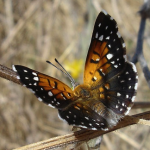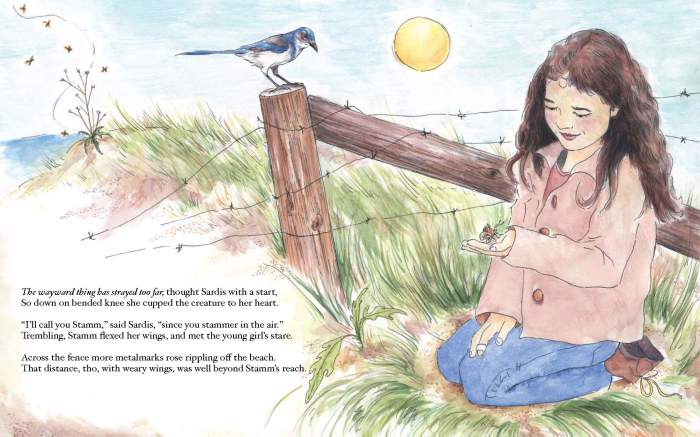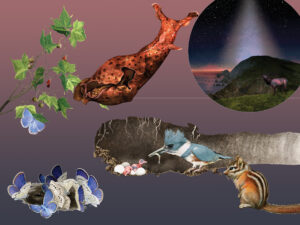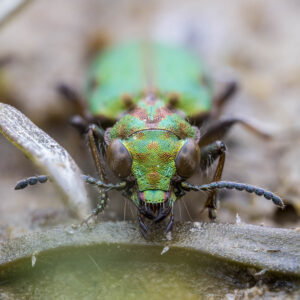Wildlife biologist and environmental science writer (and former Bay Nature contributing editor) Matthew Bettelheim temporarily switched out of his academic mode to write a children’s book that is coming out this week. Sardis and Stamm takes young readers on a journey through the unique and fragile habitat of the Antioch Dunes National Wildlife Refuge through the eyes of a young girl named Sardis. Her story introduces us to the plant and animal species that live—or lived—only at the refuge, such as the Lange’s metalmark butterfly. We spoke to Matthew as he waited for the copies of his first book to come back from the printer.

BN: Did you grow up in the Bay Area?
MB: I grew up in the East Bay, attended UC San Diego for four years where I got my B.A. in Ecology, Behavior and Evolution, and migrated back to the Bay Area after a short stint working for the state departments of Fish and Wildlife in Northern California and Oregon. I haven’t strayed from here since.
BN: What inspired you to write a children’s book about the endangered Lange’s metalmark butterfly and the dunes it lives in?
MB: The president of the Friends of the San Pablo Bay National Wildlife Refuge, Francesca Demgen, approached me about writing the book. In 2007, they’d published a children’s book (A Home for Salty) about an endangered resident of that nearby refuge —the salt marsh harvest mouse —and were interested in doing a similar book to highlight the Lange’s metalmark butterfly and its fragile habitat at the Antioch Dunes. For me, it was an opportunity to reconnect with the dunes and I leapt at the opportunity.
BN: What is the book about?
MB: A young girl named Sardis is riding her bike on a path through the dunes when a gust of wind blows a butterfly across her path. She realizes it’s been blown off the sand dunes and returns it to a buckwheat bush, which happens to be the butterfly’s host plant. Along the way the story of the girl and the butterfly gave me a chance to explore all the unique species that live on the dunes now and have lived here before. It’s sort of a portrait of the dunes’ habitat over time.
BN: Sardis is an unusual name; where did it come from?
MB: The names of the book’s two title characters, Sardis and Stamm, came from the names of the two management units of the Antioch Dunes National Wildlife Refuge. In the story, however, the girl named ‘Sardis’ names the tattered Lange’s metalmark butterfly ‘Stamm’ after noticing its trademark flight-pattern, which is erratic and “stammering” rather than graceful.
BN: Tell us about the book’s illustrator. How did you find her?
MB: Her name is Nicole M. Wong, and she now lives in New York. Francesca and I worked together to track her down. We were looking for someone who had a style we liked and we stumbled across her website.
BN: How did you publish the book?
MB: It’s self-published, thanks to a grant from the Contra Costa County Fish and Wildlife Committee Propagation Fund.

BN: Why are you interested in the Antioch Dunes?
MB: In 2005 I wrote an article for Bay Nature about the refuge that was precipitated by my interest in legless lizards. I’d come across these lizards, that generally live below ground, in my research. It turns out that legless lizards are only one of many curious creatures that can be found at the Antioch Dunes, and I was further intrigued by the innumerable endemic, rare, and extinct species known there, not to mention the dune’s long history of natural exploration and exploitation.
BN: What is ecologically unique about this spot?
MB: It’s a very small, but relatively intact dune system that used to be more prevalent in this part of the East Bay. It has a lot of native wildlife and plants that have evolved to live there. Some sands remain, but significant portions of the refuge were mined in the 1800s down to the hard pan. Much of the sand was made into bricks and shipped out to rebuild the city of San Francisco after the 1906 earthquake.
BN: How has the landscape of the Dunes been improved or degraded since 2005, when you wrote the article?
MB: The refuge staff does a lot of restoration work, but it’s a herculean task. They’re up against invasive weeds and wildfires caused by illegal campfires and smoking with limited staff and budget. And peak butterfly numbers have continued to decline into the double digits in 2013.
BN: In the past, your research has focused on the western pond turtle. How are they doing?
MB: This is my favorite species. They seem to be holding their own, but on either end of their range the population seems to be declining.
BN: What inspired your passion for pond turtles?
MB: Their historic challenges: They were once quite prolific in California’s creeks and streams, but a fishery for so-called ‘terrapins’ erupted in the San Francisco markets in the late 1800s and early 1900s to match a similar demand for diamondback terrapins along the East Coast. Having studied western pond turtles in the wild for over ten years now, I’ve come to admire them – California’s only freshwater turtle – if for no other reason than for their survivability and persistence in this increasingly inclement world.
BN: In an era of mass extinctions, are there stories that give you hope for the future?
MB: I’m always intrigued by the discovery of presumed extinct species – like the Mt. Diablo buckwheat and the Sword Lake Turtle of Vietnam, a giant soft-shell turtle of which there are only four left in the world.
BN: What’s your favorite place to hike or enjoy nature in the Bay Area?
MB: My wife and I are drawn to Mt. Diablo or any place that has a commanding view of Mt. Diablo.
Matthew’s book launch will take place on January 11th with a tour of the Antioch Dunes and a book reading and signing event by Matthew and illustrator Nicole M. Wong, at the East Bay Regional Park District’s Big Break Visitor Center in the Delta (Big Break Regional Shoreline). Click here for more info about the event and the book.





